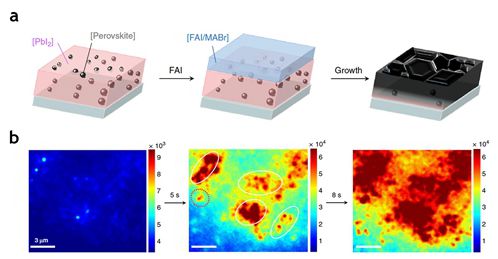Since 2009, organic-inorganic hybrid perovskite materials have attracted wide attention in the fields of energy, photovoltaics, chemistry, material physics, etc. It has continuously adjustable band gap, high light absorption coefficient, long carrier diffusion distance The simple preparation method and other excellent characteristics make it an ideal light-absorbing material for the development of next-generation photovoltaic devices. In less than 10 years of development, the energy conversion efficiency record of perovskite thin-film solar cells has rapidly increased to 23.3%, the fastest growth rate of all types of solar cells. In terms of chemical composition, organic-inorganic hybrid perovskite materials have ABX3 type crystal structure. The FAPbI3-based perovskite material with a formamidine ion content higher than 95% at the A position and a bromine ion content lower than 5% at the X position has a band gap lower than 1.55 eV. The ratio is closest to the ideal band gap of a single solar cell. At present, the long-term working stability of solar cell devices prepared by the two-step method is generally lower than that of the one-step method. This is because the traditional two-step method is difficult to obtain a perovskite film containing alkali metal ions. The research team of "Nanostructure and Low-Dimensional Physics" of the School of Physics of Peking University led by Academician Yu Dapeng has made a series of progress on this issue. Based on the traditional two-step method, Professor Zhao Qing and collaborators of the team designed and proposed a two-step spin coating method for inducing the growth of perovskite seed crystals. By introducing cesium-containing perovskite seed crystals in the lead iodide film, the Seed crystals provide nucleation sites for subsequent perovskite growth, guide high-quality thin film growth, and solve the problem of effective doping of inorganic cations in the two-step process. Through seed induction, precise regulation of nucleation and grain size can be achieved, and inorganic Cs ions are effectively incorporated, and the energy conversion efficiency of the device is increased to 21.7%. At the same time, after 140 hours of continuous operation under AM1.5G sunlight, the device still maintains an initial efficiency of more than 60%, which is far better than the stability of the traditional two-step method for several hours. Related research results were published in Nature Communications ã€Nature Communications 9, 1607 (2018). The title is “Perovskite seeding growth of formamidinium-lead-iodide-based perovskites for efficient and stable solar cellsâ€. DOI: 10.1038 / s41467-018-04029- 7]. Zhao Yicheng, a doctoral student at Peking University, Tan Hairen, a postdoctoral fellow at the University of Toronto, Canada, and Yuan Haifeng, a postdoctoral fellow at Leuven University in Belgium, are co-first authors of the research paper. Professor Edward H. Sargent and Zhao Qing of the University of Toronto are co-corresponding authors. The research team of Zhao Qing also designed a two-step method of cesium chloride-enhanced lead iodide precursor solution to further increase the content of alkali metal ions in the perovskite film while slowing the nucleation and growth process of perovskite. Perovskite polycrystalline thin film with large grains and lower density of defect states. Based on this preparation, the planar formal perovskite thin film solar cell device has a higher energy conversion efficiency (22.1%), and the long-term working stability of the device has also been improved. After working for 70 hours under AM1.5G sunlight, Still able to maintain 90% of the initial efficiency. This study provides new ideas for the problem of uniform and efficient incorporation of alkali metal ions and improvement of device performance in the two-step preparation of perovskite thin films and solar cell devices. Relevant research results are titled "Efficient Perovskite Solar Cells Fabricated Through CsCl-Enhanced PbI2 Precursor via Sequential Deposition" and published in the internationally renowned journal Advanced Materials [Advanced Materials 1803095 (2018). DOI: 10.1002 / adma.201803095]. Peking University doctoral student Li Qi is the first author of the research paper and Zhao Qing is the corresponding author. The above research has received financial support from the National Natural Science Foundation of China, the State Key Laboratory of Artificial Microstructure and Mesoscopic Physics, Peking University, and the "2011 Project" Collaborative Innovation Center for Quantum Matter Science. Coal Stove,Cooking Coal Stove,Warming Coal Stove,Backpacking Coal Stove Jinan Huancheng Heating Equipment Manufacturing Co., Ltd. , https://www.globalstove.com
A Schematic diagram of the process of preparing the perovskite thin film by the seed crystal method; b In-situ detection of the perovskite growth process in the seed crystal method by photoluminescence microscopy
Peking University School of Physics has made series in the research of high-efficiency perovskite solar cells
